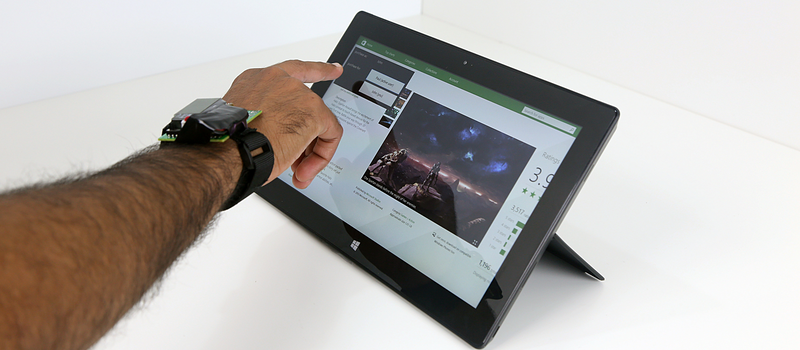Researchers [Christian Holz] and [Marius Knaust] have come up with a cool new way to authenticate you to virtually any touchscreen device. This clever idea couples a biometric sensor and low-data-rate transmitter in a wearable wrist strap that talks to the touch screen by electrifying you.
Specifically the strap has electrodes that couple a 50V, 150kHz signal through your finger, to the touchscreen. The touchscreen picks up both your finger’s location through normal capacitive-sensing methods and the background signal that’s transmitted by the “watch”. This background signal is modulated on and off, transmitting your biometric data.
The biometric data itself is the impedance through your wrist from one electrode to another. With multiple electrodes encircling your wrist, they end up with something like a CAT scan of your wrist’s resistance. Apparently this is unique enough to be used as a biometric identifier. (We’re surprised.)
The biggest limitation of this technology for authentication, in our mind, is that the “watch” can only transmit around twelve bits per second due to the relatively slow update speed of the touchscreen, which isn’t designed for this at all. Assuming that you’d want a fairly long key for security reasons, we’re afraid that you’ll be sitting there with your finger on the screen for quite a while. The researchers present a cool workaround, though. They ran a second test with an ECG electrode to the screen, run into the tablet’s sound card, and got significantly higher data-rates. (There’s also Bluetooth.)
Anyway, we think the idea of encoding user data in the background of a touch signal by electrifying your finger is pretty neat. We see more potential for fun with this device. For instance, you can have multiplayer touch-screen games where the tablet can tell who’s touching it where.
Here’s a direct link to their paper on the technique.
















not new at all, in fact PAN networks work like this. Thad Starner the father of the Wearable computer at MIT came up with this system to communicate from person to person from a handshake to share contact information. Meet a new client, shake their hand and you have their electronic business card in your phone, and they have yours.
Details and his paper were published on this back in 1993 and it worked very much like the EEG->soundcard setup described.
Disney did something similar, but without extra hardware. They used the freqency response of the fingers to distinguish persons. http://www.disneyresearch.com/project/capacitive-fingerprinting/
Well, now we must wait for a Kickstarter project for OTP Auth Watch + app, which transmits your OTP pincode to device while you draw unlocking curve. 12 bits per second, for 4 digit pin means less then 10 seconds required. Also, probably more secure then fingerprint.